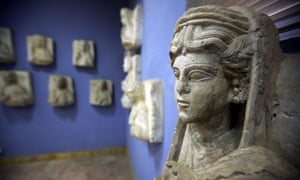The Guardian
Link

Islamic State is thought to be holding sway over half of Syria’s landmass after its seizure of Palmyra, where it has reportedly begun massacring a rebellious tribe and faces no opposition to sacking the city’s ancient ruins.
“There are no forces to stop them [entering the ruins],” Rami Abdurrahman, director of the Syrian Observatory for Human Rights, said. “But the important thing also is they now control 50% of Syria.”
Isis seized Palmyra on Wednesday night after a week-long siege that led to the collapse of forces loyal to Bashar al-Assad. The militants are drawing closer to his strongholds of Homs and Damascus and are severing supply lines to Deir Ezzor in the east, which faces an overpowering Isis crackdown.
Local activists said Isis had imposed a curfew and was sweeping the city for remnants of Assad’s forces. Isis has also killed members of the Shaitat tribe, which fought alongside the Assad regime in Palmyra and had railed against Isis in Deir Ezzor – a rebellion in which the militant group killed 800 members of the tribe.
Control of Palmyra leaves Isis with unopposed access to the city’s magnificent ruins, amid fears that they will destroy significant chunks of Syria’s heritage as it did in Iraq.
But more significantly, Isis controls vast swaths of Syria, from Palmyra to Raqqa and Deir Ezzor in the country’s west, a tract that the Syrian Observatory for Human Rights estimates to be 95,000 sq km, or more than half Syria’s landmass. With its seizure of the Arak and al-Hail gas fields near Palmyra, it also controls much of the country’s electricity supply – those two fields power much of the Syrian regime’s strongholds in the west.

Isis also controls the vast majority of Raqqa province, its de facto capital, most of Deir Ezzor, parts of Hassakeh and the Aleppo countryside, most of the Syrian desert as well as parts of the Homs countryside and the Yarmouk refugee camp in southern Damascus.
Palmyra, once a Silk Road hub and one of the cultural centres of the ancient world that occupies mythological status in Syria, is home to some of the most beautiful and well-preserved ruins of antiquity, including the Temple of Bel, built in the first century.
Isis considers the preservation of such historical ruins a form of idolatry and has destroyed temples and historic artefacts, as well as ancient Assyrian sites in Nineveh in Iraq, after conquering the province in a lightning offensive last year.

The group has profited from looting such treasures, in addition to scoring propaganda victories through the wanton destruction of archaeological sites, and Palmyra is likely to face a similar fate.
The fall of the city raises questions about the fighting capability and cohesion of Assad’s remaining troops and allied militias, whose rapid collapse surprised observers, given their close proximity to supply lines and the strategic importance of Palmyra.
The regime is stretched thin after a string of losses to rebels in Idlib in the north, who are backed by Saudi Arabia and Turkey, but residents had expected Assad’s forces to withstand the siege for longer. Instead, they appear to be retrenching in the country’s west, cutting their losses in the face of advances by Isis and the opposition.
Palmyra is the second city to be seized by Isis in less than a week, after the militants routed Iraqi security forces in Ramadi, the provincial capital of Anbar province, highlighting the group’s resilience in the face of a US-led air campaign and the limits of its strategy.

No comments:
Post a Comment